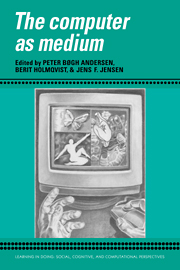Book contents
- Frontmatter
- Contents
- Series foreword
- Preface
- Contributors
- Part I Computer-based signs
- Part II The rhetoric of interactive media
- Introduction
- 6 Narrative computer systems: The dialectics of emotion and formalism
- 7 Interactive fiction: Artificial intelligence as a mode of sign production
- 8 Plays, theaters, and the art of acting in the eighteenth century: A formal analysis
- 9 The meaning of plot and narrative
- 10 Face to interface
- 11 Drawing and programming
- 12 Hypermedia communication and academic discourse: Some speculations on a future genre
- Part III Computers in context
- Index
11 - Drawing and programming
Published online by Cambridge University Press: 05 October 2010
- Frontmatter
- Contents
- Series foreword
- Preface
- Contributors
- Part I Computer-based signs
- Part II The rhetoric of interactive media
- Introduction
- 6 Narrative computer systems: The dialectics of emotion and formalism
- 7 Interactive fiction: Artificial intelligence as a mode of sign production
- 8 Plays, theaters, and the art of acting in the eighteenth century: A formal analysis
- 9 The meaning of plot and narrative
- 10 Face to interface
- 11 Drawing and programming
- 12 Hypermedia communication and academic discourse: Some speculations on a future genre
- Part III Computers in context
- Index
Summary
The authors of this chapter were involved in designing and constructing a multimedia system about the Scandinavia Bronze Age (on other ideas for multimedia applications in archaeology, see Chapter 12). The system was an advanced prototype, but near completion enough for us to be able to set it up in the museum and test user reactions. One of us was responsible for the graphics, the other for design and programming.
The system is implemented in Supercard 1.5. The design is complete, but at present the system only contains information about 70 items. It was tested at the local museum for a week. Two observers surveyed the users from an adjoining room; in addition, visitors to the museum guests were asked to fill in a questionnaire, and tape-recorded interviews were made on the spot. The system is in 8-bit color, so the black/white screen dumps in this section give only a partial impression of the real system.
The main system is for browsing and consists of four windows:
(1) A Map of Denmark and southern Sweden displaying locations of excavation sites.
(2) An imaginary Landscape. A drawing depicting an artist's view of how Bronze Age man might have viewed nature and society.
(3) A Color Photo window displaying color photos of archaeological finds.
(4) A Verbal Information window, with texts explaining the contents of the landscape and the photo window. The window also contains sound: the written texts are spoken, and the window provides samples of Bronze Age music.
- Type
- Chapter
- Information
- The Computer as Medium , pp. 236 - 262Publisher: Cambridge University PressPrint publication year: 1994
- 1
- Cited by



